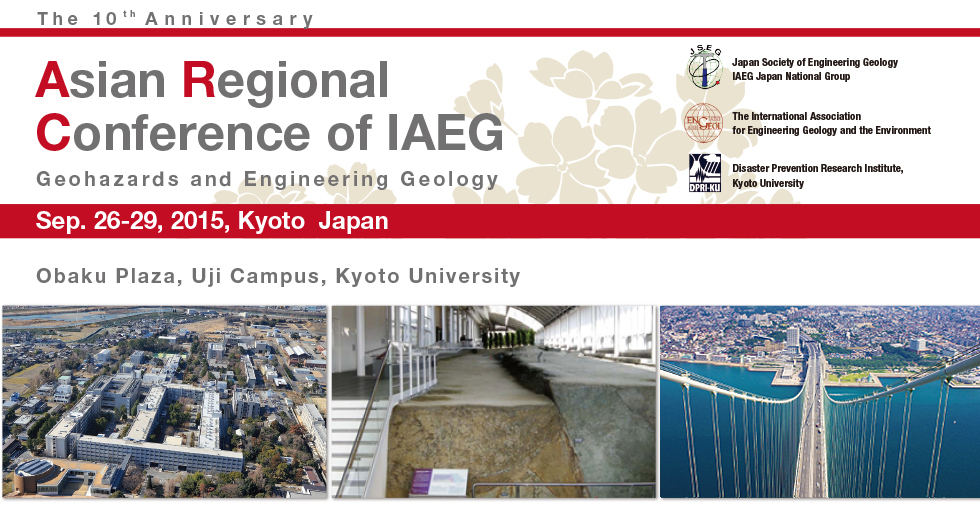Message and Preface
Message from the Conference Chairman
We are greatly honored to be able to host the 10th Asian regional conference of IAEG, which started in 1997 in a modern city Tokyo, Japan. Since then, 18 years have passed and finally it is getting back to Japan, this time to the historic city of Kyoto. In these 18 years, I am sure that Asian countries have increased the power in many aspects including science and engineering. This year is also the 70th year since the last sad WW-II. In this memorial year, we, the researchers and practitioners of engineering geology, get together and get aquatinted to each other and get charged for the future, which would become a benchmark.
We need to realize that Asian countries are definitely most susceptible to geohazards in the world and that we, the engineering geologists, know the real world of geohazards. To mitigate the disaster, the role of engineering geology have become important more and more. For example, only within recent decade, we had 2014 Hiroshima rainstorm, 2011 typhoon Talas, 2011 Tohoku earthquake, 2009 typhoon Molakot, 2009 Padang earthquake, 2008 Wenchuan earthquake, 2005 Kashmir earthquake with huge numbers of fatalities in Asian countries. Geohazards, particularly landslide hazards have been hiding behind the phenomena of rainstorm and earthquake, but they were the major causes of their fatalities except for those by Tsunami during 2011 Tohoku earthquake. Geohazards must be avoided at first by predicting where they occur. If we cannot avoid the potentially susceptible areas, we must predict when they would occur and get prepared to evacuate or make some countermeasure works. Engineering geological knowledge is indispensable to make those practices, and we must improve and innovate those techniques. For that purpose, the coming conference will give us a good chance to present research results and to discuss with other researchers from many countries with various backgrounds.
We have prepared three field trips: engineering geology in Kyoto city, the active fault that generated the 1995 Kobe earthquake, and rain-induced landslides and tunneling in accretionary complexes. The three courses include not only interesting topics of engineering geology, but also some cultural items like Japanese sake, whisky, and an historic city Nara, which used to be the capital before Kyoto.
Kyoto used to be the capital of Japan for more than 1000 years and I believe you will be able to feel this historic city during the conference. I sincerely wish all of you enjoy the conference and Kyoto and get back to your home country with something new and a good memory. Welcome to Kyoto.

Prof. Masahiro Chigira
Chairman of the Conference Organizing Committee
Past President of Japan Society of Engineering Geology
Welcome Message from Japan Society of Engineering Geology
The Japan Society of Engineering Geology (JSEG) was established in 1958 and it has a goal to facilitate the exchange knowledge and technology among the researchers and professionals of engineering geology. JSEG also aim to pursue the interdisciplinary and comprehensive research as well as technological development along with the specific contribution to the development of science, technology, and culture. Now, JSEG has about 2000 members, which makes the society one of the major academic societies of earth science in Japan.
The JSEG hosted first Asian Regional Conference on dam geology in 1997 to develop and encourage the engineering geology in the Asian region. In 1995, two years before the first Conference, the Kobe Earthquake (Mw 6.9) destructed Kobe city and took the lives of more than 6,000 people. During the last twenty years people in Asia have undergone the 1999 Chichi Earthquake in Taiwan, the 2001 Gujarat earthquake in India, the 2004 Sumatra Earthquake and Tsunami in Indian Ocean, the 2005 Kashmir Earthquake in Pakistan and India, the 2008 Sichuan earthquake, the 2011 Tohoku Earthquake and Tsunami in Japan and the 2015 Gorkha Earthquake in Nepal. As Asia lies in the Asian Monsoon Zone, typhoons, cyclones and torrent rainfalls have triggered massive floods and landslides every year. Therefore, Geodisaster Risk Reduction is very challenging task for engineering geologist in the Asia region.
JSEG is also IAEG Japan National Group and it is going to host 10th Asian Regional Conference. Through this conference, JSEG is providing opportunities to the academic researchers, engineers and engineering geologists to present and share the state-of-the-art views in field of applied geology and Geohazard. The 21th century is an age of rising Asia, but Geodisasters should not be the barriers for sustainable development in Asia. I expect more contributions of engineering geologists in the field of Geodisaster Risk Reduction.
Professor Shuichi HASEGAWA
President of Japan Society of Engineering Geology (JSEG)

Preface from IAEG President
Congratulations to the organizers of the the 10th Asian Regional Conference of IAEG that is the 26th-29th of September, 2015 in Kyoto. I am very excited about the theme of this conference which is "Geohazards and Engineering Geology" because that is my area of research. I wish that I could join you, but I have another conference at the same time in the United States that I must attend.
Takao Chaishi, Secretary General of the Japan National Group of IAEG, tells me that you will have over 150 papers presented and over 200 attendees at the meeting. This is wonderful. Congratulations to the organizers for attracting the six keynote speakers and five invited speakers from such a broad group of nations: China, Korea, Taiwan, India, Nepal, and Japan.
I wish you an exciting conference where you learn many new things and can apply them to your work. Enjoy interacting with so many friends and colleagues! Have a super meeting!
Sincerely,
Professor Scott Burns
President, International Association for Engineering Geology and the Environment President( IAEG)
Professor of Engineering Geology, Portland State University
